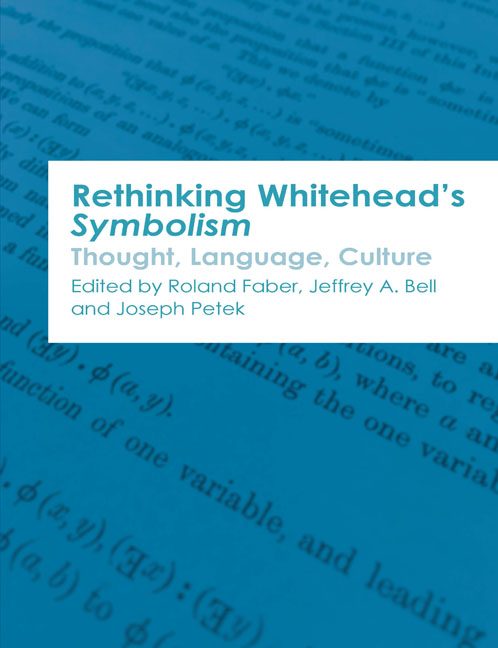Book contents
- Frontmatter
- Contents
- Abbreviations
- Introduction
- Part I Perception and Paradox
- Part II Adventures in Culture and Value
- 4 The Inhumanity of Symbolism
- 5 Reverence, Revision and Creaturely Life: Whitehead's Political Theology of Enjoyment
- 6 Ren and Causal Efficacy: Confucians and Whitehead on the Social Role of Symbolism
- 7 Avoiding a Fatal Error: Extending Whitehead's Symbolism Beyond Language
- Part III Misplaced Concreteness in Ethics and Science
- Notes on Contributors
- Index
7 - Avoiding a Fatal Error: Extending Whitehead's Symbolism Beyond Language
from Part II - Adventures in Culture and Value
Published online by Cambridge University Press: 23 June 2018
- Frontmatter
- Contents
- Abbreviations
- Introduction
- Part I Perception and Paradox
- Part II Adventures in Culture and Value
- 4 The Inhumanity of Symbolism
- 5 Reverence, Revision and Creaturely Life: Whitehead's Political Theology of Enjoyment
- 6 Ren and Causal Efficacy: Confucians and Whitehead on the Social Role of Symbolism
- 7 Avoiding a Fatal Error: Extending Whitehead's Symbolism Beyond Language
- Part III Misplaced Concreteness in Ethics and Science
- Notes on Contributors
- Index
Summary
In his foreword to Juan Eduardo Cirlot's text A Dictionary of Symbols, Herbert Read writes that every human ‘is a symbolizing animal; it is evident that at no stage in the development of civilization has man been able to dispense with symbols’. Though Alfred North Whitehead sees symbolism as being ‘essential for the higher grades of life’, he conversely states that humans are both attracted to and repulsed by symbols because ‘hard-headed men want facts and not symbols’ (PR 183; S 60). Because Whitehead saw symbols as uncontrollable, like ‘wild vegetation’ that could ‘overwhelm’ humanity, he believed that the advance of civilisation required that humans reject the superstitious symbols of their ‘savage past’ (S 60). Yet Whitehead acquiesces to the truth that despite all efforts to ‘expel’ it, symbolism – like nature – will ‘ever return’ and is ‘inherent in the very texture of human life’. He continues, ‘Mankind, it seems, has to find a symbol in order to express itself. Indeed “expression” is “symbolism”’ (S 61–2).
Whitehead writes:
the human mind is functioning symbolically when some components of its experience elicit consciousness, beliefs, emotions, and usages, respecting other components of its experience. The former set of components are the ‘symbols’, and the latter set constitute the ‘meaning’ of the symbols. (S 7–8)
Swiss psychiatrist Carl Gustav Jung agreed that symbols are powerful. He drew a distinction between symbols and signs, defining signs as ‘representations of known things’ (for example, in the way that a company's trademark represents the company itself). A symbol, on the other hand, is not the ‘logical equivalent’ of that to which it refers, but ‘points beyond itself to an unknown’. In a symbol, the ‘known and unknown’, or the ‘real and unreal’, are joined. Jung writes:
If it were only real, it would not be a symbol, for it would then be a real phenomenon and hence unsymbolic … And if it were altogether unreal, it would be mere empty imagining, which, being related to nothing real, would not be a symbol either.
- Type
- Chapter
- Information
- Rethinking Whitehead’s SymbolismThought, Language, Culture, pp. 124 - 144Publisher: Edinburgh University PressPrint publication year: 2017



